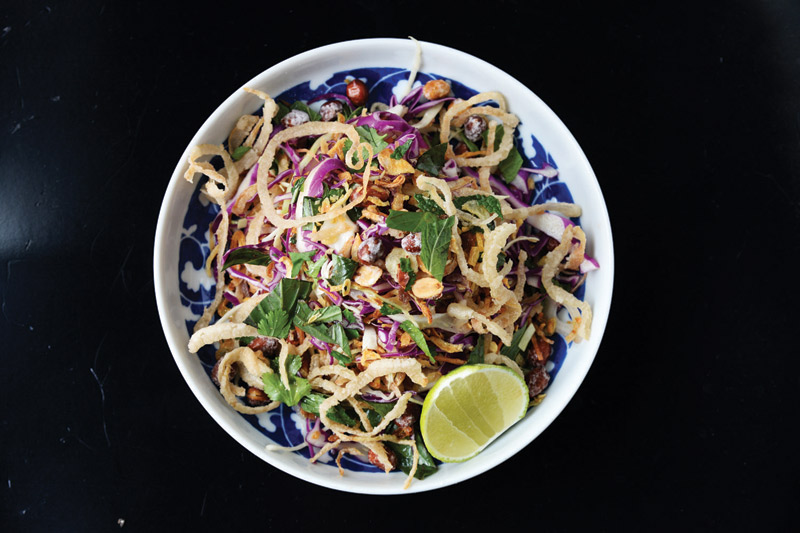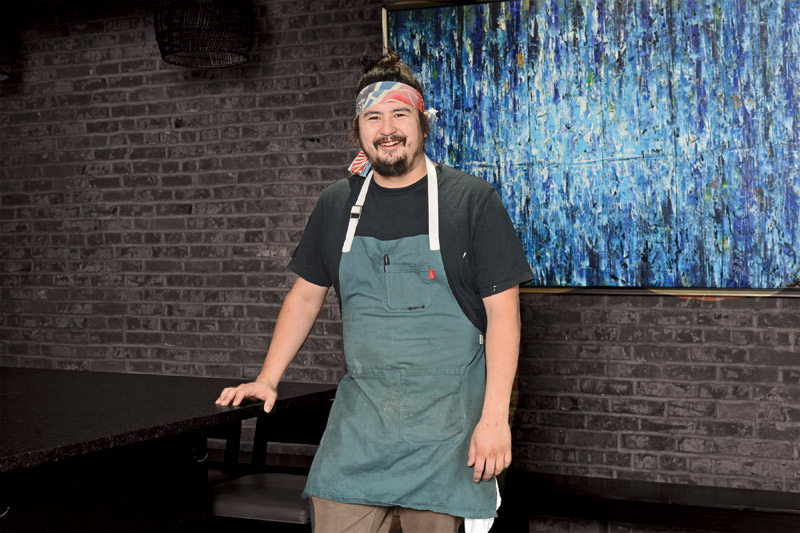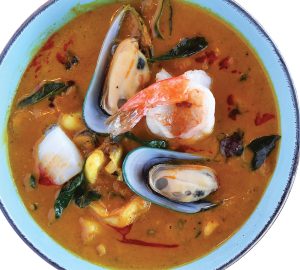Chef Nick Bognar doesn’t think Asian cooking should have to follow a strict set of traditional rules. He prefers it to be creative and unexpected and sees his new Botanical Heights dining spot, iNDO, as a proponent of the cuisine’s continued evolution.
“I love that we have chefs with different Asian backgrounds,” Bognar says of the restaurant, which opened last summer. “Mine is Thai, and we also have influences from Korea and the Philippines. We combine these with a lot of Japanese flavors and ideas as well. Our menu ranges from dishes that are simple to ones that are high-end in terms of ingredients. The flavors are very satisfying.”
There are ‘hot tastings’ like pork and chicken dumplings and lamb ribs, and ‘cool tastings’ like cabbage salad and ceviche. If you are up for sharing, there are larger entrees like short rib curry and crab donabe rice. And if you’re with a group that is feeling really adventurous, you can order omakase, which means ‘I leave it up to you’ in Japanese—in other words, you let the chef choose what you eat. “For this, guests buy a ticket, and we create a set menu,” Bognar explains. “It’s a grand tasting that takes a couple of hours. We try to have at least 17 courses, and everyone sits at the counter while I talk about the dishes and teach you about the fish we use. There are wine pairings, sake and cocktails as well. It really creates a night worth remembering.”
Bognar says he never steps out of his creative mode and constantly is thinking of ways to surprise iNDO diners. “I’m always asking how we can do new takes on ‘old school’ Japanese dishes,” he says. “We make sashimi with isaan hamachi (yellowtail) and Thai ingredients like coconut cream, fish sauce, crispy candied garlic, shallots and a paste of chilis.” There is also a broiled lobster thermidor (traditionally a French dish) that he embellishes with Asian ingredients. “It’s a little outside of the traditional,” he notes. Special sauces, curries and soy reductions round out the palate for many of his creations.
A 2019 James Beard semifinalist, Bognar is known for his sushi, and he enjoys working with fresh, Asian fish and shellfish flown to the U.S. and driven in daily from Chicago. “I started working at the sushi bar at my family’s restaurant when I was 16,” he says. “I got good at making rolls and other simple preparations, and later, I moved to Austin, Texas, where I built a fundamental skill set in fine dining. When I returned to St. Louis, I started researching new kinds of fish and dishes to make with them. Especially when it comes to sushi, I always strive to keep learning.”
The chef says that because he works with a lot of fats and oils at the restaurant, he tries to cook on the “lighter, brighter side” during his off hours. “I like to make Thai food and one-pot dishes at home,” he says. “I do salads, vegetables and wraps a lot. One of my favorite things is to saute fresh ingredients for a Thai salad.” While he enjoys traveling for pleasure, Bognar never really hangs up his figurative chef’s hat. “I go to Thailand at least once a year and always find great ideas for dishes,” he says. “As soon as I arrive, I head out with my uncle, who knows where all of the best spots are. We almost never get past the first block without eating somewhere.”
When it comes to running his own restaurant, Bognar believes in letting staff members bloom where they feel most comfortable. “Others are good at the business end of it, but I’ve stuck with the culinary side,” he says. “The food is the part of restaurant work that makes the most sense to me. I like to create a sustainable culture where everyone is happy with what they’re doing.”

cabbage salad
serves four
½ head green cabbage
¼ head red cabbage
1 c loose Thai basil
½ c fresh mint
½ c fresh cilantro
1 white onion
1 qt. cornstarch
1 c plain peanuts
2 qts. vegetable oilfor frying
1 c sugar
½ c water
Roast peanuts at 375 degrees for 10 min. Boil sugar and water to 240 degrees; pour syrup over roasted peanuts in a mixing bowl, and stir well.
Thinly slice onion and season with salt. Coat with cornstarch in a bowl and deep fry in oil at 300 degrees. Drain and set aside.
Slice cabbage thinly and rinse in cold water. Tear up herbs and put half in a bowl with cabbage along with half the onions and peanuts.
Toss salad with dressing and garnish with remaining herb mixture, peanuts and onions.
dressing
1 lb. palm sugar
16 oz. fish sauce
½ c lemon juice
2 T tamarind concentrate
6 pieces fresh Thai chili
½ t ground dried Thai chili
Simmer mixture until sugar dissolves, then cool.
Photos by Bill Barrett








